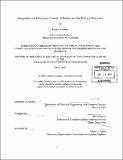Computational disclosure control : a primer on data privacy protection
Author(s)
Sweeney, Latanya
DownloadFull printable version (20.86Mb)
Other Contributors
Massachusetts Institute of Technology. Dept. of Electrical Engineering and Computer Science.
Advisor
Hal Abelson.
Terms of use
Metadata
Show full item recordAbstract
Today's globally networked society places great demand on the dissemination and sharing of person specific data for many new and exciting uses. When these data are linked together, they provide an electronic shadow of a person or organization that is as identifying and personal as a fingerprint even when the information contains no explicit identifiers, such as name and phone number. Other distinctive data, such as birth date and ZIP code, often combine uniquely and can be linked to publicly available information to re-identify individuals. Producing anonymous data that remains specific enough to be useful is often a very difficult task and practice today tends to either incorrectly believe confidentiality is maintained when it is not or produces data that are practically useless. The goal of the work presented in this book is to explore computational techniques for releasing useful information in such a way that the identity of any individual or entity contained in data cannot be recognized while the data remain practically useful. I begin by demonstrating ways to learn information about entities from publicly available information. I then provide a formal framework for reasoning about disclosure control and the ability to infer the identities of entities contained within the data. I formally define and present null-map, k-map and wrong-map as models of protection. Each model provides protection by ensuring that released information maps to no, k or incorrect entities, respectively. The book ends by examining four computational systems that attempt to maintain privacy while releasing electronic information. These systems are: (1) my Scrub System, which locates personally-identifying information in letters between doctors and notes written by clinicians; (2) my Datafly II System, which generalizes and suppresses values in field-structured data sets; (3) Statistics Netherlands' pt-Argus System, which is becoming a European standard for producing public-use data; and, (4) my k-Similar algorithm, which finds optimal solutions such that data are minimally distorted while still providing adequate protection. By introducing anonymity and quality metrics, I show that Datafly II can overprotect data, Scrub and p-Argus can fail to provide adequate protection, but k-similar finds optimal results.
Description
Thesis (Ph. D.)--Massachusetts Institute of Technology, Dept. of Electrical Engineering and Computer Science, 2001. Includes bibliographical references (leaves 213-216) and index.
Date issued
2001Department
Massachusetts Institute of Technology. Department of Electrical Engineering and Computer SciencePublisher
Massachusetts Institute of Technology
Keywords
Electrical Engineering and Computer Science.